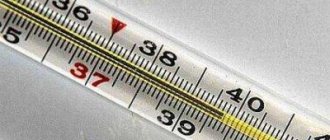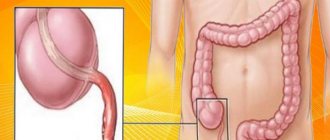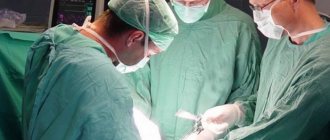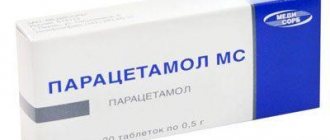Temperature after surgery - is this normal? This question may arise for any patient who has undergone surgery. The results of thermometry, that is, measuring body temperature, are the data on which the doctor relies when assessing the patient’s condition over time. High numbers indicate the occurrence of fever, but additional examination is required to establish the exact cause. An increase in temperature after surgery is a nonspecific symptom that occurs in a variety of conditions, not all of which can be called a disease.
Postoperative fever is considered an increase in temperature above 38.5 °C, which is recorded at least 2 times during the first 24 hours after completion of the operation.
However, with the development of postoperative complications, body temperature can be subfebrile - this depends on the type of pathology, age and condition of the patient, and a number of additional factors. Therefore, other criteria for determining fever are used - an increase in temperature of more than 37.2 °C in the morning and more than 37.7 °C in the evening.
Temperature after surgery in a child or adult may be due to:
- Infection.
- Phlebothrombosis.
- Thyrotoxic crisis.
In some cases, fever is explained by immune disorders, the development of a rejection reaction after transplantation, the presence of a neoplasm, and exacerbation of chronic concomitant diseases. An increase in temperature in combination with a decrease in blood pressure is characteristic of acute adrenal insufficiency.
In the first hours after surgery on the stomach or other organ, the temperature may rise due to trembling. Severe shivering occurs as a compensatory reaction if, during surgery, the body experiences heat loss (intraoperative hypothermia) due to low temperature in the operating room, the administration of anesthetics, transfusion of solutions and the use of breathing mixtures that were not sufficiently warmed. The temperature reaches 38–39 °C and returns to normal after the shaking stops.
A temperature of 37.1–37.4 °C after abdominal and thoracic surgery may persist for several days. If the patient feels satisfactory, there are no pathological changes in the area of the surgical wound, there is no reason to think about infection or other complication.
Symptoms
Fever is usually accompanied by:
- General malaise, drowsiness.
- Trembling, chills, followed by a feeling of heat.
- Decreased or lack of appetite.
- Loss of body weight.
- Pain in muscles, joints.
- Increased skin sensitivity.
Increased blood pressure and tachycardia (increased heart rate) are classic symptoms of a temperature reaction.
In some diseases they are absent, but the opposite phenomenon may occur – bradycardia.
How long does the fever last after surgery?
The normal temperature after the operation is considered to be a temperature that does not exceed 37.6°C. This condition lasts no more than 3-7 days. After a week, the temperature returns to normal and the patient’s condition improves significantly.
However, if after 15-30 days the temperature has not returned to normal or its periodic increase is observed, this may indicate the development of postoperative pathological processes in the body.
It is worth understanding that it is not the fact of temperature rise itself that is alarming, but the duration of this phenomenon.
If the temperature persists for more than 7 days, this is a serious cause for concern.
Infection
Infection is one of the most common causes of fever after knee surgery or other surgery. The group of common infectious complications includes:
- surgical wound infection;
- urinary tract infections;
- respiratory system infections.
According to clinical observations, the assumption of infection is more correct the later the fever appears.
In the first hours after lung surgery, the temperature is of non-infectious origin, but if a febrile reaction occurs on the second day and beyond, it is necessary to include infectious pathology in the diagnostic search.
The likelihood of developing complications largely depends on the degree of bacterial contamination of the wound.
Temperature after abdominal surgery for appendicitis is observed, as a rule, with delayed intervention and the presence of peritonitis. If the lumen of the digestive, respiratory and urinary tract is opened, the wound is considered conditionally contaminated, the risk of purulent infection increases by 5–10% compared to a clean wound surface (during prosthetics, hernia repair). Open fractures and fecal peritonitis belong to the group of contaminated wounds, in which infection is observed in almost 50% of cases.
In addition to wound infection, complications can be caused by artificial ventilation of the lungs (pneumonia), the use of a urethral catheter (cystitis), or venous access (thrombophlebitis). A temperature after surgery to remove the gallbladder above 38.5 °C should suggest a possible purulent infection (liver abscess, subdiaphragmatic abscess, peritonitis). The list of possible infectious diseases, one way or another related to surgical intervention, is quite wide. It is necessary to assume infection in the presence of elevated temperature after surgery, pain, redness and swelling in the area of the surgical wound, and the presence of purulent discharge.
It is necessary to pay attention not only to the presence of fever.
It is important to evaluate its duration, time of occurrence, the presence of sharp drops and rises in temperature, as well as symptoms indicating the location of the lesion.
For example, if the temperature after heart surgery is combined with weakness, chills and the appearance of heart murmurs, there is reason to suspect infective endocarditis.
The basis of treatment is antibacterial therapy. If infection is associated with a urethral or venous catheter, it must be removed. When a purulent focus (abscess, phlegmon) forms, surgical intervention is required.
Itching and burning
Anal itching and burning sensation after surgery are caused by:
- increased secretion of mucus from the rectum;
- the appearance of a fissure in the rectum;
- inflammation;
- internal hemorrhoidal cones;
- violation of the prescribed diet.
Sometimes the itching is progressive and so painful that the patient continues to scratch constantly and agrees to any treatment.
Itching appears in cases of non-compliance with the diet. A quick effect appears if you stop drinking strong coffee, tea, and food with spicy seasonings; the itching disappears without treatment.
The burning sensation is caused by irritation of the mucous membrane with solid or liquid feces, mucus when internal nodes fall out.
Mucus is produced normally by the intestines. But if the operation is carried out incorrectly, its number can increase sharply. In this case, a large amount of mucus causes itching or burning. These symptoms are sometimes the beginning of a more serious complication. When visiting a doctor, recurrent hemorrhoids may be discovered.
Phlebothrombosis
During anesthesia, the activity of the blood coagulation system increases and blood flow slows down. Phlebothrombosis is a likely complication of general anesthesia with the use of muscle relaxants, more often observed in patients over 40 years of age. The risk of blood clots in the veins increases with a large volume of surgery, duration of surgical intervention over 4 hours, obesity, varicose veins of the lower extremities. A symptom of thrombosis may be fever after surgery to remove a tumor.
Clinical manifestations of deep vein thrombosis of the lower extremities:
- Weakness, increased body temperature.
- Swelling and pain in the limb.
- Pale or bluish coloration of the skin.
Patients require bed rest, elevated positioning, and elastic bandaging of the limb. Anticoagulants (fraxiparin, heparin, phenylin) and antiplatelet agents (chirantil, trental) are prescribed. Thrombolysis (dissolution of a blood clot by administering streptokinase, streptase) is used according to strict indications due to the risk of bleeding. Removal of a blood clot can also be done surgically.
Rectal prolapse due to valve insufficiency
After hemorrhoidectomy, cases of rectal prolapse are common. This occurs due to a weak valve. Valve insufficiency is a fairly rare pathology that develops in people with severe hemorrhoidal disease. Loss occurs:
- immediately after completion of the operation;
- a few hours or days after it.
The reason is a violation of the integrity of the sutures due to coarse feces. Drug treatment is prescribed or surgical correction is performed. Men are more susceptible to developing complications. During the recovery period, diet, massage, and special exercises are used to strengthen muscles.
Thyrotoxic crisis
One of the most likely endocrine disorders in the postoperative period is thyrotoxic crisis - a condition caused by a sharp increase in the level of thyroid hormones in the blood.
Occurs in patients with diffuse toxic goiter in case of untimely detection of pathology and/or lack of adequate therapy. During surgery, the body experiences stress associated with anesthesia and surgery - this is a trigger for the development of thyrotoxic crisis. The following symptoms are observed:
- restlessness and agitation;
muscle weakness, trembling of limbs;- nausea, vomiting, abdominal pain, diarrhea;
- decrease in the amount of urine excreted;
- tachycardia, decreased blood pressure;
- fever, profuse sweating.
High temperature after surgery on the thyroid gland, intestines and other organs, which is a manifestation of thyrotoxic crisis, is an indication for emergency medical care. Thyreostatic drugs (mercazolyl), beta-blockers (anaprilin, propranolol), glucocorticosteroids (prednisolone), and infusion therapy are used.
Treatment of hyperthermia
If the fever is caused by postoperative complications, begin to treat the source of the problem. Treatment methods at this stage are chosen by the doctor. They range from stopping the inflammatory process with antibiotics, to repeated surgery to invasively eliminate the source of infection.
At home, you can reduce your temperature with the following medications:
or their analogues.
It is important to remember that drugs containing paracetamol have a negative effect on kidney function, and tablets and powders should be used according to the instructions, without exceeding the norm. If the operation was associated with pathologies of the genitourinary system, then paracetamol drugs are completely contraindicated.
Important! To treat fever in children under 16 years of age, the drug Nimesil is used.
For fever with a temperature above 39 degrees, use the “triad”, a mixture of Diphenhydramine, Analgin and No-shpa intramuscularly.
What to do in case of fever after surgery?
It is important to know that the highest temperature is observed in the first days after surgery. Then it gradually begins to decrease to its natural values.
If doctors diagnose normal postoperative recovery, no additional manipulations or prescriptions are performed. However, if after 10-15 days there is no tendency towards normalization of improvement in the patient’s condition, the cause and essence of the complications that have arisen are clarified.
An ultrasound and blood test are prescribed as mandatory diagnostic measures. The doctor also examines the integrity of the sutures and the wound itself for the presence of inflammatory processes. After establishing the true cause of the persistence of a high temperature, complex treatment is prescribed, which includes:
- Therapy using antibiotics. Doctors select the drugs used based on the general clinical picture of the patient. Treatment depends on the type of causative agent of the inflammatory process.
- Anti-inflammatory treatments are carried out using Ibuprofen (NSAIDs).
- To normalize the temperature, antipyretics are used, such as: Paracetamol, Aspirin, etc.
How to determine a complication
The split seam is immediately visible. But the overall picture of the patient’s condition is not always immediately visible. Therefore, you need to focus on the following signs:
- slow wound healing (very deviates from the norm);
- changes in the edges of the wound (redness, color change, bruising);
- active formation of pus;
- symptoms of pneumonia (persistent cough without sputum, loud wheezing).
Attention! The main symptom is always a prolonged fever. It can be observed even for more than a month.
Causes of peritonitis
Primary peritonitis
The inflammatory process in this case occurs against the background of preserved integrity of the internal organs of the abdomen and is a consequence of spontaneous blood dissemination of bacteria into the peritoneum. Primary inflammation of the peritoneum is in turn divided into:
- spontaneous peritonitis in children;
- spontaneous inflammation of the peritoneum in adults;
- tuberculous inflammation of the peritoneum.
Pathogenic pathogens represent one type of infection or monoinfection. The most common type is streptococcus pneumoniae. In sexually active women, inflammation of the peritoneum is usually caused by gonococci and chlamydia. In the case of peritoneal dialysis, gram-positive bacteria (eubacteria, peptococci and clostridia) are detected.
In children, spontaneous inflammation of the peritoneum, as a rule, occurs in the neonatal period or at 4–5 years. At four to five years of age, systemic diseases (scleroderma, lupus erythematosus) or kidney damage with nephrotic syndrome are a risk factor for the development of this complication.
Spontaneous inflammation of the peritoneum in adults often occurs after emptying (drainage) of ascites, which is caused by cirrhosis of the liver or after long-term peritoneal dialysis.
Tuberculous damage to the peritoneum occurs with tuberculous damage to the intestines, fallopian tubes (salpingitis) and kidneys (nephritis). Mycobacterium tuberculosis enters the serous tissue of the abdominal cavity through the bloodstream from the primary source of infection.
Secondary peritonitis
Secondary inflammation of the peritoneum is the most common type of described complication and includes several varieties:
- inflammation of the peritoneum caused by impaired integrity of internal organs (as a result of their perforation or destruction);
- postoperative;
- post-traumatic inflammation of the peritoneum as a result of blunt trauma to the abdominal area or penetrating injury to the abdominal cavity.
The causes of the first group of inflammation of the peritoneum are the following types of pathologies:
- inflammation of the appendix (appendicitis), including perforation of the appendix (gangrenous and perforated appendicitis);
- inflammation of the internal genital organs in women (salpingitis and oophoritis, endometritis), as well as ruptures of an ovarian cyst or fallopian tube during ectopic pregnancy or in the case of pyosalpinx;
- intestinal pathology (intestinal obstruction, intestinal diverticula, Crohn's disease with perforation of ulcers, perforation of duodenal ulcers, perforation of intestinal ulcers of other etiologies: tuberculosis, syphilis, etc., malignant intestinal tumors and their perforation);
- diseases of the liver, pancreas and biliary tract (gangrenous cholecystitis with perforation of the gallbladder, suppuration and rupture of various hepatic and pancreatic cysts, rupture of parapancreatic cysts, cholelithiasis).
Peritonitis after surgery is classified as a separate group, despite the fact that this type of disease is caused by abdominal trauma. But it should be taken into account that the injury caused by the operation is inflicted on the patient under certain conditions, in compliance with the rules of asepsis, and the negative response of the body to the surgical injury is associated with complex anesthetic management.
Post-traumatic inflammation of the peritoneum occurs as a result of a closed abdominal injury or due to a penetrating injury to the abdomen. Penetrating wounds can be caused by a gunshot wound, stab objects (knife, sharpening) or due to iatrogenic factors (endoscopic procedures accompanied by damage to internal organs, abortion, uterine curettage, hysteroscopy).
Tertiary peritonitis
This type of inflammation of the peritoneum is the most difficult to diagnose and treat. Essentially, this is a relapse of previous inflammation of the peritoneum, and, as a rule, occurs after surgery in those patients who have experienced emergency situations, as a result of which their body’s defenses are significantly suppressed.
- significant exhaustion of the patient;
- a sharp decrease in plasma albumin levels;
- identification of microorganisms resistant to multiple antibiotics;
- progressive multiple organ failure.
Tertiary inflammation of the peritoneum is often fatal.
Inflammatory diseases of various organs located in the abdominal cavity - cholecystitis, pancreatitis, appendicitis, salpingitis.
Perforations in the gastrointestinal tract (stomach, intestines, gall bladder, etc.), which can act as complications of gastric or duodenal ulcers, appendicitis, destructive cholecystitis, ulcerative colitis, and malignant diseases. This leads to the fact that the contents of the stomach, gall bladder, and bladder (hydrochloric acid, bile, urine, blood) enter the free abdominal cavity, which causes irritation and then inflammation.
The infection enters the circulatory or lymphatic system (hematogenous and lymphogenous pathways), which leads to the spread of pathogenic microflora throughout the body, and accordingly, affects the abdominal cavity. This can occur with direct infection of the body, or secondarily, when the infection enters the blood from boils, carbuncles and other infectious foci on the skin.
Injury to the abdominal organs, or the abdomen itself - development occurs during injuries, after surgical treatment.
Other reasons include:
- Rupture of appendicitis;
- Ultra-high distension of the intestine with intestinal obstruction;
- Necrosis of the gastrointestinal tract;
- The presence of ulcers in lymphoid plaques during typhoid fever;
- Excessive production of serous fluid in the abdomen or disruption of its circulation (ascites);
- Internal bleeding and others.
The most common pathogens of peritonitis are bacteria - staphylococci, streptococci, pneumococci, Escherichia coli, Enterobacter, Enterococcus, Eubacteria, Peptococcus, Clostridia, Proteus, Fusobacteria, Bacteroides, Mycobacterium tuberculosis.
Quite often, inflammation of the peritoneum is caused by the association of several types of infection simultaneously.











